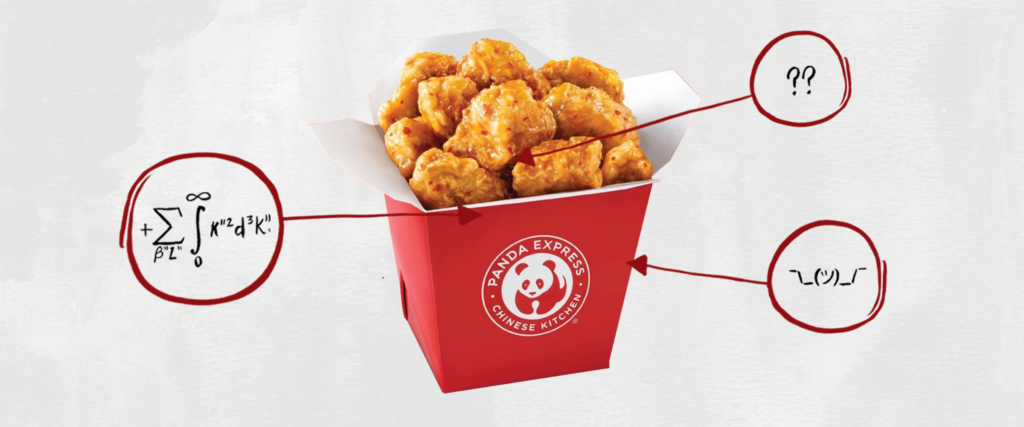We’re often told that you should never eat anything (or put anything on your body) if you don’t recognize what’s in the ingredients list. But since most of us have no idea what xanthan gum or potassium benzoate are — or more importantly, what they’re doing to our bodies — we’re decoding the ingredients in the many things Americans put in (and on, or near) themselves.
This edition: Panda Express’ Original Orange Chicken, which is made from at least 25 separate ingredients that we’ve broken down as they appear on their website. (Also, some good news for vegans: Panda Express partnered with Beyond Meat to offer a plant-based version of their Orange Chicken — the ingredients aren’t available yet, but you can check out our look at the Beyond Burger here.)

The Chicken
1) Dark Meat Chicken: Dark meat is fattier than white meat.
2) Water: I love my chicken soaked.
3) Sugar: In total, a serving of Orange Chicken has 19 grams of sugar, or about four and half teaspoons. Damn.
4) Distilled Vinegar: Or rather, vinegar produced from the fermentation of distilled alcohol. It adds flavor.
5) Modified Food Starch: Modified food starch is made from a variety of foods, usually corn, potatoes and/or tapioca. It also has a variety of uses, but it likely works as an anti-caking agent here, preventing the breading around the chicken from clumping.
6) Corn Starch: This coats the chicken, resulting in a crispier outer edge during the frying process.
7) Potato Starch: This does the same thing as corn starch.
8) Wheat: Same as above.
9) Orange Extract: This is what gives Orange Chicken its strong orange flavor.
10) Caramel Color: Caramel color lends the chicken its golden-brown hue. Unfortunately, it has a controversial byproduct called 4-methylimidazole (4-MEI): A 2007 study found that mice fed a diet of 4-MEI developed cancerous lung tumors as a result. The FDA pushed back, explaining that a human would have to consume more than 1,000 cans of soft drinks (which are notoriously high in caramel coloring) every day for two years to reach comparable levels of 4-MEI.
Who’s right is still unclear. More recent studies argue that levels of 4-MEI are, in fact, high enough in soda (and possibly other foods) and consumed in sufficient quantities by Americans to increase the risk of developing cancer. Even more recent studies say that caramel coloring is just fine. So you can decide for yourself on this one.
11) Salt: A bit of flavor.
12) Garlic: Bad for breath, great for taste.
13) Phosphoric Acid: Phosphoric acid is tangy and prevents the growth of mold and bacteria.
14) Rice: I guess there’s rice… in the chicken?
15) Sesame Oil: This keeps the chicken moist, but ingested in large amounts, vegetable oils can cause all sorts of problems, including fatty liver disease, insulin resistance and migraines. That said, sesame oil is generally considered to be one of the good ones.
The Batter
Technically, both the batter and sauce (more on that in a moment) are proprietary, so we don’t know everything that’s in them. However, Panda Express shares the basic ingredients:
1) Wheat Flour: A very common flour used for frying.
2) Salt: A little more flavor.
3) Eggs: Can’t have chicken unless it’s covered in more chicken, right?
4) Spices: These are proprietary, remember?
5) Leavening: There are all kinds of specific leavening ingredients, but they more or less do the same thing: Help the outer crust maintain its form.
The Sauce
1) Water: Water is the base of most sauces.
2) Sugar: We talked about this already — Orange Chicken is pretty sugary.
3) Soy Sauce: You knew it would be in here somewhere.
4) Salt: It’s everywhere.
5) Spices: Again, these are proprietary.
The Takeaway
There’s nothing in here that worries me too, too much. Sure, it could do without the caramel color. And yeah, maybe less sugar, too. But truthfully, I’ll eat it either way.

